NCERT Solutions for Class 6 Maths Chapter 4 - Basic Geometrical Ideas
Exercise 4.1
Q1. Use the figure to name:
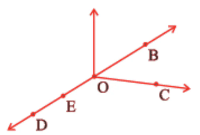
(a) Five points
(b) A line
(c) Four rays
(d) Five line segments
Ans:
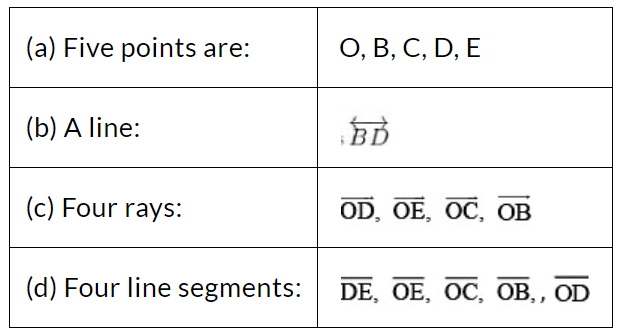 Q2. Name the line given in all possible (twelve) ways, choosing only two letters at a time from the four given.
Q2. Name the line given in all possible (twelve) ways, choosing only two letters at a time from the four given.
 Ans:
Ans:

Q3. Use the figure to name:
 (a) Line containing point E.
(a) Line containing point E.
Ans: A line containing 
(b) Line passing through A.
Ans: A line passing through 
(c) Line on which O lies.
Ans: A line on which O lies 
(d) Two pairs of intersecting lines.
Ans: Two pairs of intersecting lines are 
Q4. How many lines can pass through
(a) one given point?
Ans: Infinite number of lines can pass through one given point.
(b) Two given points?
Ans: Only one line can pass through two given points.
Q5. Draw a rough figure and label suitably in each of the following cases:
(a) Point P lies on  .
.
(b)  intersect at M.
intersect at M.
(c) Line l contains E and F but not D.
(d)  meet at O.
meet at O.
Ans:
Q6. Consider the following figure of line  Say whether following statements are true or false in context of the given figure.
Say whether following statements are true or false in context of the given figure.
(a) Q, M, O, N, P are points on the line 
Ans: True
(b) M, O, N are points on a line segment 
Ans: True
(c) M and N are end points of line segment 
Ans: True
(d) O and N are end points of line segment 
Ans: False
(e) M is one of the end points of line segment 
Ans: False
(f) M is point on ray 
Ans: False
(g) Ray  is different from ray
is different from ray 
Ans: True
(h) Ray  is same as ray
is same as ray 
Ans: False
(i) Ray  is not opposite to ray
is not opposite to ray 
Ans: False
(j) O is not an initial point of 
Ans: False
(k) N is the initial point of  and
and 
Ans: True
Exercise 4.2
Q1. Classify the following curves as (i) Open or (ii) Closed.(a)
Ans: Open curve
(b)
Ans: Closed curve
(c)
Ans: Open curve
(d)
Ans: Closed curve
(e)
Ans: Closed curve
Q2. Draw rough diagrams to illustrate the following:
(a) Open curve
Ans: Open curves


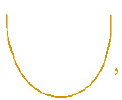
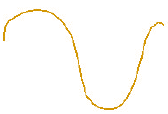
(b) Closed curve
Ans: Closed curves
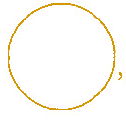
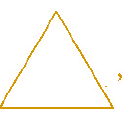


Q3. Draw any polygon and shade its interior.
Ans: Polygon ABCDE
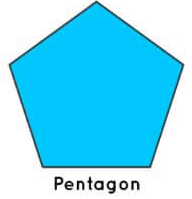
Q4. Consider the given figure and answer the questions:
(a) Is it a curve?
(b) Is it closed?
 Ans: (a) Yes, it is a curve.
Ans: (a) Yes, it is a curve.
(b) Yes, it is closed.
Q5. Illustrate, if possible, each one of the following with a rough diagram:
(a) A closed curve that is not a polygon.
Ans: The below figure is a closed figure but not a polygon.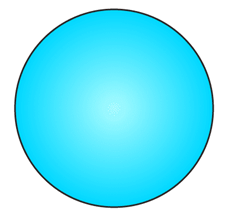
(b) An open curve made up entirely of line segments.
Ans: The below figure is an open curve made up entirely of line segments.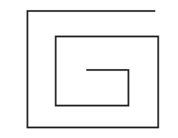
(c) A polygon with two sides.
Ans: No, it’s not possible, as the polygon with the least number of sides is a triangle, which has three sides.
Exercise 4.3
Q1. Name the angles in the given figure.
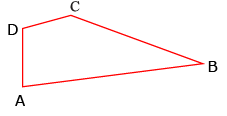 Ans: There are four angles in given figure:
Ans: There are four angles in given figure:
∠ ABC, ∠ CDA, ∠ DAB, ∠ DCB
Q2. In the given diagram, name the point(s)
(a) In the interior of ∠DOE
Ans: The point in the interior of ∠DOE is A
(b) In the exterior of ∠EOF
Ans: The points in the exterior of ∠EOF is C, A and D
(c) On ∠EOF
Ans: The points on ∠EOF are E, B, O and F
Q3. Draw rough diagrams of two angles such that they have
(a) One point in common.
Ans: O is the common point between ∠COD and ∠AOB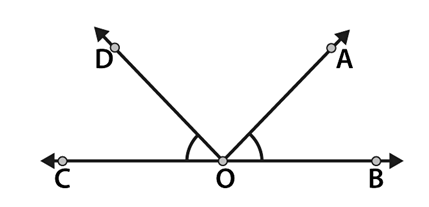
(b) Two points in common.
Ans: O and B are common points between ∠AOB and ∠BOC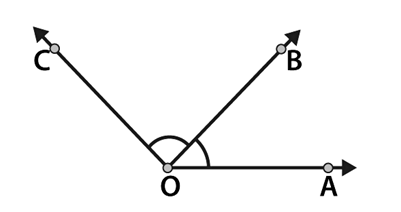
(c) Three points in common.
Ans: O, E and B are common points between ∠AOB and ∠BOC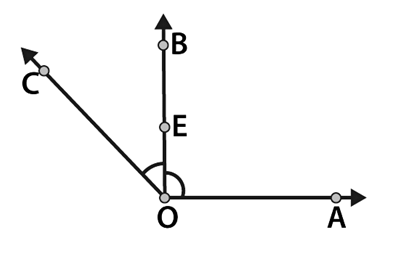
(d) Four points in common.
Ans: O, E, D and A are common points between ∠BOA and ∠COA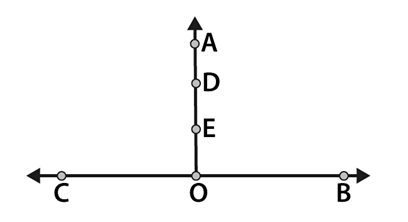
(e) One ray in common.
Ans: OC is a common ray between ∠BOC and ∠AOC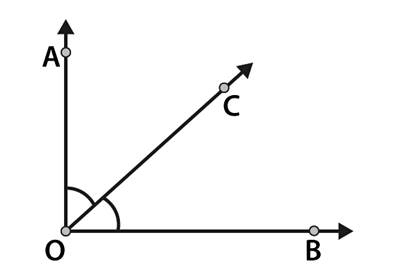
|
30 videos|120 docs|59 tests
|
FAQs on NCERT Solutions for Class 6 Maths Chapter 4 - Basic Geometrical Ideas
| 1. What are the basic geometrical ideas covered in Class 6 NCERT Solutions? |  |
| 2. How can NCERT Solutions for Basic Geometrical Ideas help in understanding geometry concepts better? |  |
| 3. Are the exercises in NCERT Solutions for Basic Geometrical Ideas sufficient for practice and preparation for exams? |  |
| 4. Are the Old NCERT exercises in Basic Geometrical Ideas still relevant for Class 6 students? |  |
| 5. How can students make the most of NCERT Solutions for Basic Geometrical Ideas to improve their problem-solving skills? |  |

















